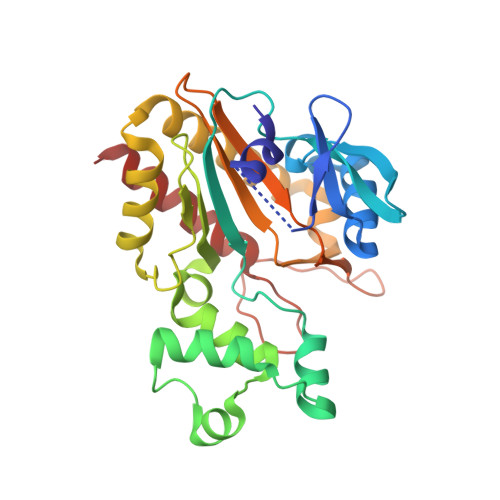Substrate promiscuity of inositol 1,4,5-trisphosphate kinase driven by structurally-modified ligands and active site plasticity.
Marquez-Monino, M.A., Ortega-Garcia, R., Whitfield, H., Riley, A.M., Infantes, L., Garrett, S.W., Shipton, M.L., Brearley, C.A., Potter, B.V.L., Gonzalez, B.(2024) Nat Commun 15: 1502-1502
- PubMed: 38374076
- DOI: https://doi.org/10.1038/s41467-024-45917-5
- Primary Citation of Related Structures:
8PP8, 8PP9, 8PPA, 8PPB, 8PPC, 8PPD, 8PPE, 8PPF, 8PPG, 8PPH, 8PPI, 8PPJ - PubMed Abstract:
D-myo-inositol 1,4,5-trisphosphate (InsP 3 ) is a fundamental second messenger in cellular Ca 2+ mobilization. InsP 3 3-kinase, a highly specific enzyme binding InsP 3 in just one mode, phosphorylates InsP 3 specifically at its secondary 3-hydroxyl group to generate a tetrakisphosphate. Using a chemical biology approach with both synthetised and established ligands, combining synthesis, crystallography, computational docking, HPLC and fluorescence polarization binding assays using fluorescently-tagged InsP 3 , we have surveyed the limits of InsP 3 3-kinase ligand specificity and uncovered surprisingly unforeseen biosynthetic capacity. Structurally-modified ligands exploit active site plasticity generating a helix-tilt. These facilitated uncovering of unexpected substrates phosphorylated at a surrogate extended primary hydroxyl at the inositol pseudo 3-position, applicable even to carbohydrate-based substrates. Crystallization experiments designed to allow reactions to proceed in situ facilitated unequivocal characterization of the atypical tetrakisphosphate products. In summary, we define features of InsP 3 3-kinase plasticity and substrate tolerance that may be more widely exploitable.
- Department of Crystallography and Structural Biology, Institute of Physical-Chemistry Blas Cabrera, CSIC, Serrano 119, 28006, Madrid, Spain.
Organizational Affiliation:




















